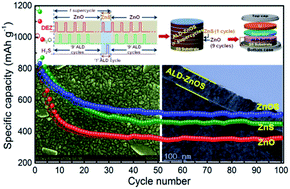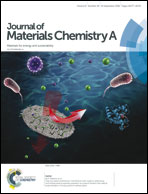Atomic layer deposited zinc oxysulfide anodes in Li-ion batteries: an efficient solution for electrochemical instability and low conductivity†
Abstract
In addition to their optoelectronic applications, Zn-based oxides and sulfides have also been widely studied as electrode materials in Li-ion batteries owing to their high theoretical capacity. However, both the materials suffer from a drastic loss in capacity due to their poor conductivity and electrochemical instability. A very efficient and carefully controlled combination of these two may address these limitations. In this work, thin films of zinc oxysulfide (ZnOS) with an O/(O + S) ratio of ∼0.7 were deposited using a combination of oxide and sulfide atomic layer deposition (ALD) cycles; they were then tested as anodes in Li-ion batteries. The material was grown directly on a stainless steel substrate (SS), characterized extensively using several ex situ characterization tools, and then used as an anode with no binder or conductive additives. Cyclic voltammetry measurements were used to confirm the reversible conversion of ZnOS in addition to the well-known alloying–dealloying Li–Zn reaction. The material loading was further optimized by varying the number of ALD supercycles to attain the maximum stable cycling performance. The highest stable capacities of 632.9 and 510.3 mA h g−1 were achieved at current densities of 0.1 and 1 A g−1 (∼4 and 40 μA cm−2), respectively, for a ZnOS film with an optimum thickness of ∼75 nm. The optimized ZnOS anode exhibited superior electrochemical performance in comparison to the equivalent pristine ZnO and ZnS anodes. Finally, the post-cycling analysis of the binder-free ALD grown ZnOS anodes demonstrated excellent adhesion to the SS substrate and the high stability of these films upon cycling.



 Please wait while we load your content...
Please wait while we load your content...